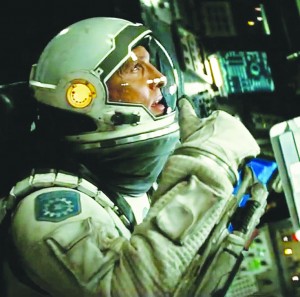Film review: ‘Interstellar’ is “visually dazzling”
By Muhammad MuzammalCOLUMNIST
Visually dazzling and powerfully affecting, Christopher Nolan’s “Interstellar” is both a transcendent experience and an intellectually engaging blockbuster. This is a pure science fiction work that takes on the difficult task of being smart, breathtaking and surreal at the same time, all the while staying grounded in its humanistic plea for our species’ survival.
“Interstellar” begins with a town in mid-western America, year unspecified. Famine has caused overpopulation and a mysterious blight is killing crops and creating widespread dust storms.
Enter Cooper (Matthew McConaughey), a former NASA engineer who owns acres of farmland which he shares with his family. His family consists of his chatty son Tom (Timothée Chalamet), his space whiz daughter Murph (Mackenzie Foy) and his caring father-in-law Donald (John Lithgow). The widowed family man Cooper is called to go on a space mission.
Said mission comes to be when Cooper runs into a super-secret location, almost by supernatural means. The location is a think-tank for NASA, dedicated to saving the human race. Led by Dr. Brand (Michael Caine), NASA develops two plans.
Plan A involves creating a space vessel, big enough to transport Earth humans to a distant world and Plan B involves using frozen embryos to colonize another world. Thinking of his children, Cooper takes on Plan A with Brand promising to create the necessary equation to overcome gravity so that the vessel can be built.
Cooper pilots the aptly named space craft "Endurance," to find a distant world. He is joined by a a crew full of brilliant, brave astronauts: Brand’s loving daughter Amelia (Anne Hathaway), scientist Doyle (a deadpan Wes Bentley) the worried Romilly (David Gyasi ) and the sarcastic, witty robot TARS HAL 9000 (Bill Irwin), with more personality. The journey involves wormholes, black holes and time travel; all of which last a measly two years for Cooper but twenty-three years go by on Earth. The resentful, adult Murph (Jessica Chastain) works for NASA, the same entity that took Cooper away from her.
Like all of Nolan’s best works ("Inception, The "Dark Knight" Trilogy, "Memento") “Interstellar” is full of story and relies on plot. The film offers twists which highlight deception being linked to desperation and reveals human nature to be far more complex than the scientific jargon the film throws at us.
It also uses a lot of jargon. The movie at times feels like an advanced physics course bunched into three hours. There are also sappy, hokey lines, which reflect Nolan’s sophism as a writer of the Spielbergian genre.
Despite its flaws, this film is one of Nolan's best. Having the most 35/70 mm IMAX footage of any film of all time, "Interstellar" is viscerally glorious and looks best during the space sequences, which feel more like NASA space footage than actual special effects. Nolan's colorful, surreal vision of space takes precedence when Cooper and crew lift off into the deeper cosmos, through the wormholes and into the icy, watery worlds.
This film is an involving experience. Mixing in Richard King's in-your-face sound effects and Hans Zimmer's ethereal, driving, almost religious organ heavy music, "Interstellar" tells its story best through its filmic elements, letting us feel the loneliness of space and the longing the human characters have to go back to Earth.
There's a brilliant scene in which peaceful, harmonious nature sounds accompany the flight of Endurance. It's a creative and innovative choice, showing the viewers that no matter how far the astronauts are from Earth, their humanity stays with them (a thematic link to Tarkovsky's "Solaris").
"Interstellar" is Nolan's most artistic film, and not in the same vein as that of the thrilling, edge-of-your-seat exciting experiences of his previous films. Nolan slows the action down and lets us explore the psychological pains of the crew members, specifically Cooper and Amelia, who both long to return to the people they love, a familial aspect that relates the two personalities.
The performances don't feel staged by the film, but greatly complement the movie. Hathaway is hopeful as Amelia, who believes that love is the one thing that transcends time and space. Chastain/Foy both portray Murph as a fiesty, go-getter who misses her father but regrets his departure.
McConaughey's raw, tender performance is one of his best performances. The actor, who has recently risen to a more respectable level of acting, is vulnerable, strong and desperate as Cooper, a man who will go further than any human in history to go back to his children.
There's a touching scene where Cooper watches video recordings of his children and as they age through time, and he begins crying. The camera doesn't cut to any image but the one of Cooper, in pain and sadness over not seeing his children grow up. This may be the most poignant scene in Nolan's career and, for a father of four; it may also be his most personal and intimate scene.
"Interstellar" is flawed but the experience of watching this is overwhelmingly amazing. I have mentioned Christopher Nolan is almost every paragraph in this review. There is no better filmmaker working in the industry today that can take $200 million and make a movie that is as intelligent, audacious, and challenging like "Interstellar."
Nolan juggles time, family, sacrifice and love in a movie that is as beautiful as it is foolhardy. For all its risks, "Interstellar" pays off mesmerizingly and leaves us not grounded but like its heroes, up in the air, swept by the beauty of such an epic piece of cinema.
